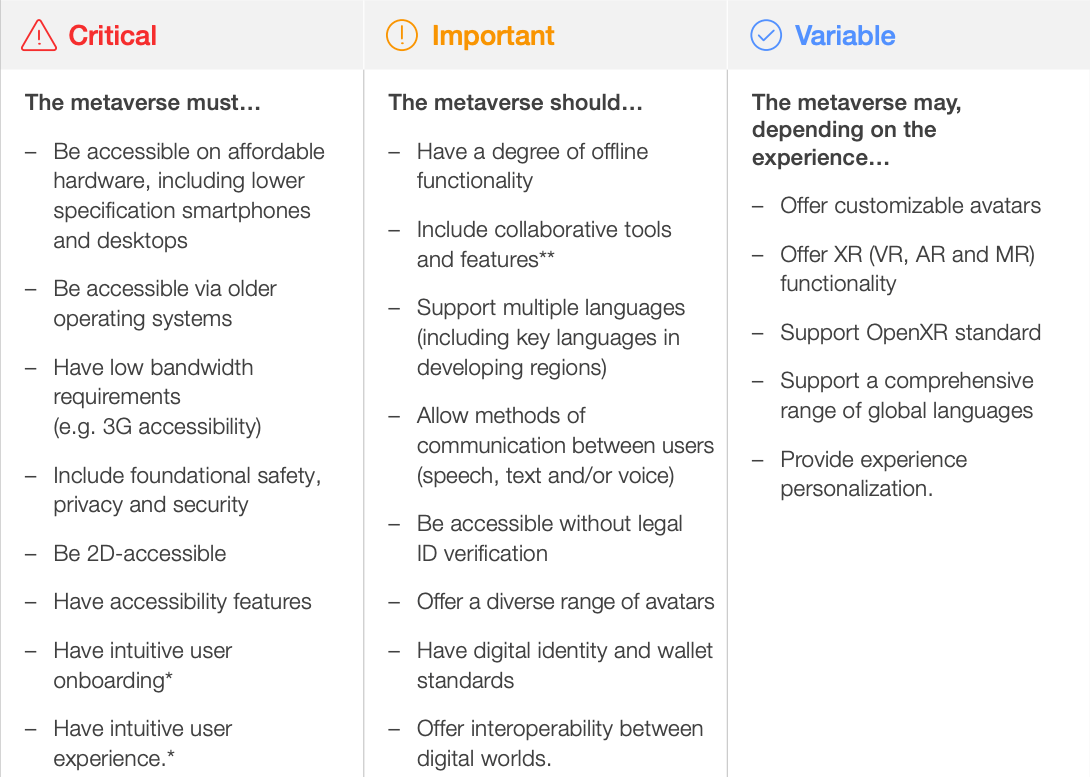Although shiny new products excite tech enthusiasts, they are not available to all. Concerned observers wonder: who will be able to access the metaverse?
The Digital Divide
Roughly one-third of the global population remains unconnected to the internet. Expensive devices price out consumers and, for those that can afford them, poor connectivity prevents or discourages their use. In yet other instances, products are designed such that they cannot be enjoyed by those with disabilities.
The result: many enjoy the internet whilst others cannot. This digital divide reveals disparities across economic backgrounds, age, gender, race, languages, and abilities.
Accessibility in the metaverse
The price and complexity of immersive technology create new challenges for diversity. Users with different devices or internet connections may have vastly different experiences.
The World Economic Forum recently set out critical, important, and variable elements that metaverse experiences should have to broaden adoption:

The Sandbox celebrated its second Belonging Week, dedicated to celebrating diversity and inclusion through avatars, virtual art exhibitions and other metaverse experiences.
Beyond adoption
Innovations in metaverse technology, such as device vibrations for feedback or sign language avatars, can open up new experiences for those with disabilities. A compelling example is augmented reality subtitles for people who are hard of hearing:
But to ensure broad accessibility across the metaverse, technology providers need to consider the impact of their designs at the stage of development, rather than the stage of deployment, and work together to share best practices.
Into the EU metaverse…
Policy
European Commission
The European Commission published a Communication on “Web 4.0 and virtual worlds: a head start in the next technological transition.” The document introduces definitions, brings attention to the economic potential of virtual worlds, and outlines the EU’s strategy for the technological transition.
The Joint Research Center of the EU published an in-depth study on Next Generation Virtual Worlds: Societal, Technological, Economic and Policy Challenges for the EU.
European Parliament
Internal Market and Consumer Protection Committee (IMCO)
The Culture and Education Committee published their ‘Opinion,’ to inform IMCO’s upcoming report. Led by Renew’s Laurence Farreng 🇪🇺🇫🇷, CULT calls on the EU to boost funding, promote cultural diversity, and provide education and training.
Legal Affairs Committee (JURI)
On 19 July, the Committee held an exchange of views on the legal implications of Virtual Worlds. A
TwitterX thread followed the conversation.
🇪🇺 European Commission’s Vice President Margrethe Vestager, on the potential of the metaverse 👇
Research
The Centre on Regulation in Europe published a study: “Defining Virtual Worlds: Main Features and Regulatory Challenges.” Key points are summarised here.
The World Economic Forum's Defining and Building the Metaverse Initiative published two reports:
Business
XR4Europe launched the IMPULSE Programme, an accelerator for European XR projects. The call is open until 28 August.
🇩🇪 Siemens is investing €1 billion to create a blueprint for the Industrial Metaverse.
🇫🇷 L’Occitane teamed up with Emperia Collaborate to launch a virtual metaverse store.
🇩🇪 BMW unveiled Motorrad MetaRide, a virtual world where users can ‘test ride’ BMW’s new motorbike, the CE 02.
🇫🇮 Nokia released research with EY, presenting the findings of a survey over 860 business leaders about the metaverse.
🇩🇪 German football coach credits BeYourBest VR training for his team’s recent success winning the U17 European Championship
🇫🇷 Microoled, a manufacturer of augmented reality displayers, received €23 in funding.
🇩🇪 BMW announced ConnectedRide Smartglasses, augmented reality glasses that provide motorbike riders with a heads-up display:
Events
Policy
Conferences
18 Oct – 20 Oct Stereopsia (Brussels 🇧🇪)
24 Oct – 25 Oct AWE EU (Vienna 🇦🇹)
25 Oct – 26 Oct Metaverse Summit & Awards (Berlin 🇩🇪)
Image credit: Paul Jennings




